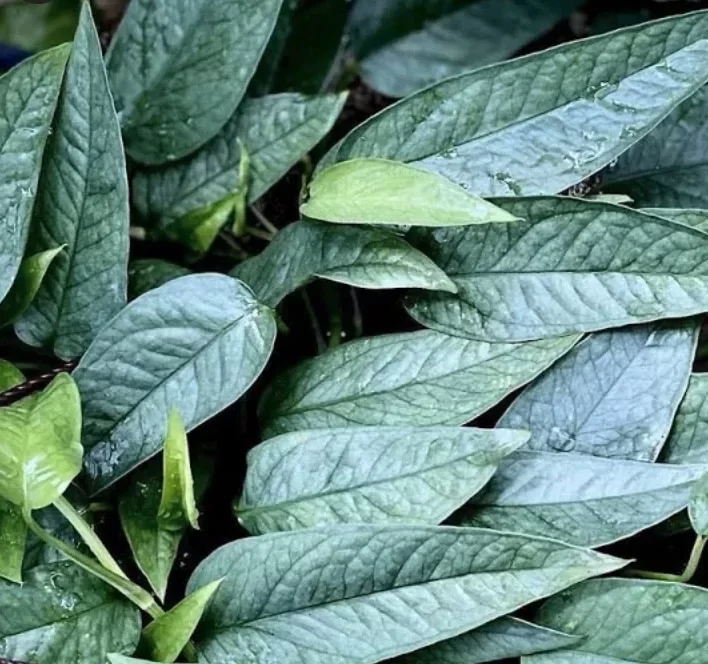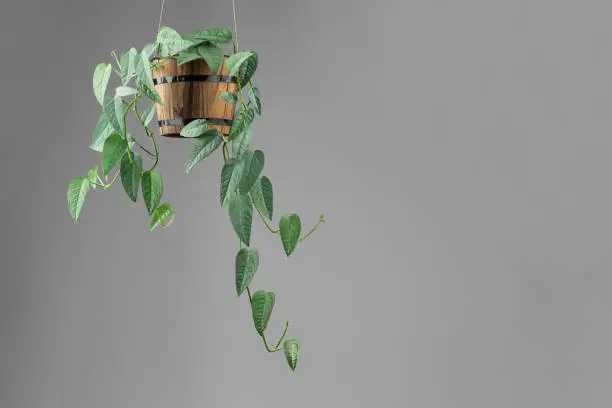Cebu Blue Pothos is an adorable house plant—known for its ease of care and manageable growth through regular trimming. Its unique ability to flourish in low-light conditions adds charm to indoor plants. Originating from the Philippines, this tropical vine is known for its unique and vibrant appearance, making it a perfect addition to any indoor space. However, the greenery of Epipremnum pinnatum ‘Cebu Blue’ is often adorned with attractive silver speckles, adding to its overall charm.

Characteristics and Appearance of Cebu Blue Pothos
Cebu Blue Pothos is characterized by its long, trailing stems that can grow up to 20 feet long. The leaves are silver-blue, glossy, which sets them apart from other varieties of pothos.
These roots help the plant absorb moisture and nutrients from the air, making it highly adaptable and easy to care for. However, Epipremnum pinnatum ‘Cebu Blue’ is a slow-growing plant, but with proper monitoring, it can survive and become a beautiful focal point in your home.
Additional details about Cebu Blue Pothos
Cebu Blue Pothos is known for its striking blue-green leaves and is a popular choice for indoor and low-light spaces due to its relatively low maintenance requirements.
| Features | Details |
| Scientific name | Epipremnum pinnatum ‘Cebu Blue’ |
| Common Name | Cebu Blue Pothos |
| Family | Araceae |
| Plant Type | Vine / Epiphyte |
| Sun exposure | Indirect daylight to moderate shade |
| Soil Type | Well-drained potting mix, rich in organic matter |
| Soil pH | Slightly acidic to slightly alkaline (around 6.0 – 7.0) |
| Height | Can trail or climb up to several feet (2-15+ feet). |
| Spacing | 1.5 – 3 feet apart when planting multiple plants |
Benefits of Growing Cebu Blue Pothos
Besides its aesthetic appeal, Cebu Blue Pothos offers several benefits, making it a popular indoor gardening choice. Firstly, it is known for its air-purifying properties. Like other plants in the Pothos family, Cebu Blue Pothos can remove harmful toxins, such as formaldehyde and benzene, from the air, improving the overall air quality in your home. However, the Epipremnum pinnatum ‘Cebu Blue’ has calcium oxalate crystal toxins that are toxic to pets if ingested. Keep it out of reach of cats, dogs, and other animals tempted to chew on the leaves.
Additionally, this houseplant is relatively low-maintenance, making it suitable for both experienced gardeners and beginners. Its trailing nature also makes it an excellent choice for hanging baskets, shelves, or as a trailing plant on top of cabinets and bookshelves.
Furthermore, you can trim your Blue Pothos to a manageable size. Use scissors to cut any leggy or overgrown stems.
Cebu Blue Pothos’ trailing nature makes it an excellent choice for hanging baskets, where its long stems gracefully cascade down. You can also place Cebu Blue Pothos on shelves, bookcases, or as a tabletop centerpiece. However, the Epipremnum pinnatum ‘Cebu Blue’ can also add a touch of greenery to bathrooms and kitchens, as it can tolerate high humidity levels.
Read: Eupatorium Perfoliatum – Propagation, Care, and Uses

Cebu Blue Pothos: Light, Water, and Temperature Requirements
It is essential to provide it with the right amount of light and water, and maintain optimal temperature conditions, to ensure the healthy growth of your Cebu Blue Pothos[1]Pothos Plant Caring checklist. Read. Meanwhile, the following information will guide you through the care requirements for a Blue Pothos houseplant.
Light requirements:
Cebu Blue Pothos survive in bright, indirect light conditions. It prefers bright, filtered light but can tolerate lower light levels. However, avoid placing it in direct daylight exposure, as this can burn the leaves and provoke them to turn yellow. If you notice that the plant is not growing as expected or is losing its vibrant color, it may be an indication that it needs more light. On the other hand, if the leaves are becoming pale or developing brown patches, they may be receiving too much light.
Watering:
As a tropical plant, Epipremnum pinnatum ‘Cebu Blue’ prefers moderately moist soil. It is crucial to water the plant schedule, allowing the top inch (1-2 Inches) of soil to dry out between each watering. Overwatering can affect roots and lead to other fungal diseases. During winter, reduce the watering frequency as the plant’s growth slows down.
Temperature and Humidity:
Cebu Blue Pothos develop well in average room temperatures ranging between 65-80°F (18-27°C). It can tolerate slightly lower temperatures but is sensitive to sudden temperature fluctuations. A humidity level of around 40-60% is ideal for this plant. If the air in your home is dry, especially during the winter, Place a tray of water to balance humidity near the houseplant or use a humidifier.
Fertilizer:
Fertilize your Cebu Blue Pothos once every 2-4 weeks during the spring and Fall using a balanced houseplant fertilizer. Reduce or eliminate fertilization during winter when the plant’s growth slows down.

Additional Details about Caring for Cube Blue Pothos
Here is a summary of all propagation monitoring aspects.
| Aspect | Information |
| Light | Bright and indirect. |
| Watering | Allow the top of the soil to dry between Spring-Fall; keep it moist in winter. Avoid settling water at the top or bottom. |
| Fertilizer | Cebu Blue Pothos once every 2-4 weeks during Spring-Fall. |
| Soil | Use soil with charcoal. Place in indirect bright light, with no direct sun exposure. |
| Size | Vines can reach 10-20 feet (120-240 inches) untrimmed. |
| Temperature | 65 – 80 °F (18-27°C) |
| Humidity | Low but can survive in highly humid areas like the bathroom. |
| Leaves | Silverish-blue shimmery leaves. |
Propagating Cebu Blue Pothos: Methods and Tips
Propagating Cebu Blue Pothos is rewarding and cost-effective. There are two standard and straightforward approaches to propagation: water propagation and stem cutting.
Water propagation:
Take a two-four healthy stem leaves to propagate Cebu Blue Pothos in water. Trim the stem just 1 inch below a node. Place the cut in a water-filled jar, ensuring the node is submerged. Put the glass jar in a location with bright, indirect daylight and change the water weekly. After some time, roots will develop, and once they reach a sufficient length, you can replant them in a pot with well-drained soil.
Stem cutting:
Another method of propagation is stem cutting. Cut a stem with at least 2-4 leaves just below a node using a scissor or pruning shear. Detach the lower leaves and place the cutting in a pot filled with well-drained soil. Water the cutting thoroughly and put it in a location with bright, indirect light. Keep the soil slightly moist, and the roots will develop in a few weeks. Once the roots are well-established, you can treat the cutting as a mature plant.
When propagating Cebu Blue Pothos, it is crucial to provide the new plants with the exact care requirements as the parent plant. It will ensure their healthy growth and development.

Read: Propagate Pothos Like a Pro: Your Essential Guide
Cebu Blue Pothos Propagation Gone Wrong? Stay Aware of These Pitfalls!
The various pitfalls that can occur during Cebu Blue Pothos propagation. However, the following are significant issues that Epipremnum pinnatum ‘Cebu Blue’ faced during the propagation period.
Common Issues/Pitfalls and Reasons
Overwatering: Providing too much water can lead to root rot and other issues. Pothos prefer slightly moist soil.
Underwater condition: Neglecting enough water can result in undersized growth and wilting of the plant.
Using incorrect soil: Inappropriate soil can inhibit root growth and plant health. Use a well-drained mixture or use growth hormones.
Improper Light: Too much daylight exposure can burn the leaves, while low light can lead to leggy growth.
Too cold temperatures: Cebu Blue Pothos is sensitive to freezing; it evades exposure to temperatures below 50°F (10°C).
Ignoring Humidity Needs: Low humidity can cause browning of leaf edges; misting or using a humidity tray can help.
Not Allowing Proper Drainage: Lack of drainage in the pot can lead to soggy roots and eventual plant decay due to the settling of water at the bottom.
Crowded Planting: Planting multiple cuttings in the same pot or jar too closely can interfere with each plant’s growth and airflow.

However, cognition of these causes can aid you in evading common missteps during Cebu Blue Pothos propagation and confirm the successful maturing of your plants.
Addressing Common Issues When Growing Cebu Blue Pothos
Growing Cebu Blue Pothos can be a rewarding experience, but like any plant, it may face specific issues. Here are some common problems you may encounter and how to address them:
Yellow leaves:
Yellowing leaves[2]Reason Behind Blue Pothos leaves turning Yellow. Read can indicate overwatering, underwater, or inadequate light. Check soil moisture and adjust your watering routine accordingly. Ensure that the plant receives the right amount of light, and move it to a brighter location if needed.
Leaf twisting:
Leaf curling is often the result of underwater or low humidity. Increase the watering frequency and consider using a humidity tray or humidifier to provide the plant with adequate moisture.
Brown Edges:
Several factors, including extremely low humidity, over-fertilizations, or exposure to cold conditions, can cause brown tips on the leaves. Increase humidity levels, avoid over-fertilizing the plant, and ensure it is not kept in a cold environment.
By addressing these common issues promptly and providing the necessary care, you can ensure the healthy growth and longevity of your Epipremnum pinnatum ‘Cebu Blue’.
Read: Baltic Blue Pothos: Captivating Elegance in Greenery!
Why are Cebu Blue Pothos perfect for indoor plants?
To cut the blog short, Cebu Blue Pothos is a prominent houseplant that offers various benefits. Low monitoring, ease of care, and air-purifying properties make it popular among indoor or outdoor gardeners. However, by providing the right amount of light and water and maintaining optimal temperature conditions, you can propagate this plant simply and safely.
Whether you hang it in a basket, place it on a shelf, or train it along a trellis, Cebu Blue Pothos will undoubtedly add beauty to any interior.



